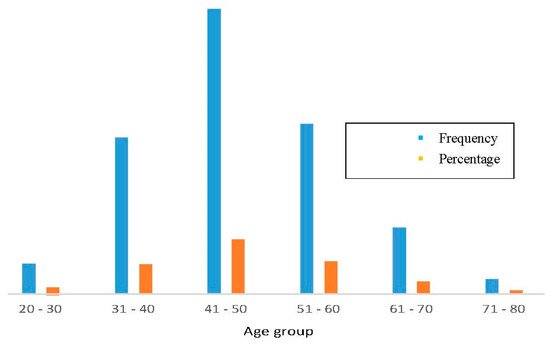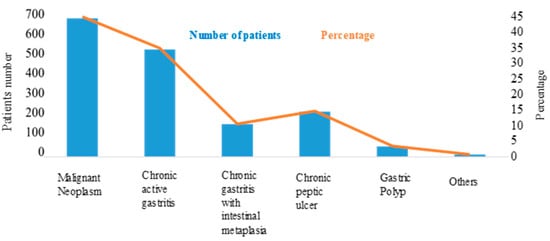You're using an outdated browser. Please upgrade to a modern browser for the best experience.
Please note this is an old version of this entry, which may differ significantly from the current revision.
Subjects:
Health Care Sciences & Services
Cancer is responsible for killing more people than HIV, malaria, and TB combined [1]. Lower-income and lower-middle-income countries are mainly affected by these deadly diseases.
- carcinoma
- cancer
- formalin
- smoking
- food habit
- diseases
1. Cause of Lung Cancer
To maintain freshness, the chemical formalin is extensively used for fruits, fish, and vegetables. Formalin-treated foods are openly sold in markets in less-developed countries, especially Bangladesh. Ingesting these foods may cause different types of cancer, predominantly lung cancer [15]. Smoking, tobacco use, previous history of lung disease such as asthma or tuberculosis, and genetic factors are the key factors in the development of lung cancer [16]. Polymorphic changes in the MDM2 gene have been identified as another reason for lung cancer, based on data collected from more than 11,638 patients [17]. Age is another important parameter. People older than 65 years of age are significantly affected compared to younger people in less-developed countries. It was reported that about 5887 lung cancer patients were admitted to the hospital in 2020, especially the National Institute of Cancer Research and Hospital (NICRH). Experts have suggested that smoking and air pollution are the main reasons for lung carcinoma [18]. Family income, area of residence, education status, and marital status are the four most common contributing factors in lung cancer, mainly for men older than 55 [19].
1.1. Prevalence of Lung Cancer
In 2012, an estimated 14.1 million people were affected by cancer and about 8.2 million died [7]. Among them, 17.8% died due to lung cancer. This rate was comparatively higher than stomach and liver cancers [20,21]. A study was conducted of 104 male and female individuals (about 94.20 and 5.80%, respectively) in different areas of Bangladesh. Important risk factors for developing lung cancer in Bangladesh were identified. The following order was shown for males—smoking > previous history of lung disease > highly cooked food > genetic inheritance > tobacco leaf intake > alcohol consumption; while the following order was shown for females—genetic inheritance < highly cooked food < previous history of lung disease < tobacco leaf intake [22]. Every year, more than 190,000 people are affected by lung cancer in Bangladesh. Approximately 30,000 patients are expected to die from this cancer [23,24]. A report published in 2020 indicated that among 400 cancer patients in 2016, 11 patients were affected by lung cancer, with a male-to-female ratio of 10:1. According to the report, the highest-selling lung cancer drugs, including cisplatin, gefitinib, and osimertinib, are being produced by top-ranked pharmaceutical companies in Bangladesh [24].
2. Cause of Liver Cancer
Hepatocellular carcinoma (HCC), i.e., liver cancer, is the third most common cancer, behind lung and gastric carcinoma [25]. About 8 million people in Bangladesh are infected with chronic hepatitis B or C virus. This can proceed to HCC, and recently non-alcoholic fatty liver disease (NAFLD) has been shown to increase the trend toward liver cancer [26,27]. For the manufacturing and processing of sutki (the local name for dried fish), dichlorodiphenyltrichloroethane (DDT) is commonly used, although it is banned by the government. This is also responsible for liver cancer [15].
2.1. Prevalence of Liver Cancer
Hepatocellular carcinoma is usually a male-predominant disease in Bangladesh, affecting men between the ages of 41–92 years [28]. A study was conducted by Karim et al. at Dhaka Medical College of 79 patients with hepatocellular carcinoma, based on age, sex, and HbsAg (Figure 2). Another study found a male predominance for this disease and concluded that HBV was responsible for 61.5% of cases of HCC in Bangladesh [28,29]. The average age of hepatocellular carcinoma patients in Bangladesh is 41–92 years [30]. According to a WHO report in 2018, the number of hepatocellular carcinoma cases was 3112 and the mortality rate was 2.68% [31]. Current treatment includes the use of sorafenib and pegylated interferon alpha, as most liver cancer is related to hepatitis infection. The hepatitis B core antigen-based vaccine is gaining popularity for prevention of liver carcinoma [6].

Figure 2. Scenario of hepatocellular carcinoma in Bangladeshi males and females based on age, sex, and HBsAg. Liver carcinoma from 2001 to 2002 was more prevalent in males than in females. A study of 39 male and female patients found the same incidence of HBsAg-related liver carcinoma in males and females.
3. Cause of Breast Cancer
Female gender, age, obesity, menarche (under 12 years of age), and radiation therapy to the chest or breasts are the main factors for breast cancer (BC) development [32,33,34]. One prevalent major risk factor among women was found to be overweight. In addition, menarche, contact with radiation to the chest or face, and age under 40 years were identified as major risk factors among Bangladeshi women. Family history is also a predominant factor in breast cancer [35]. The tendency to avoid breastfeeding and the changing reproductive system may increase the risk of breast cancer [36]. With the lack of accessibility to a hospital and the cost of diagnosis, many women are unwilling to seek a diagnosis due to their socio-economic status. Improper treatment, poverty, and late diagnosis are also contributing factors [37,38]. A report published by NICRH indicated that illiterate housewives were highly prone to be affected by breast cancer. Women living in urban areas are different from women in rural areas in their reproductive behavior; they are reluctant to marry, have children, or breastfeed [39]. The use of chemicals in dermatological products and crop production and bisphenol A in plastic materials is changing the secretion of estrogen, also leading to breast cancer development [38].
3.1. Prevalence of Breast Cancer
The incidence of breast cancer in developing countries is increasing significantly day by day. It has been estimated that more than 1.67 million people were identified as breast cancer patients [40], especially premenopausal women [41]. One of the biggest cancer-based hospitals in Bangladesh is the National Institute of Cancer Research and Hospital (NICRH). The hospital conducted a study from 2005–2010 among 5255 breast cancer patients in different age groups, from 15 to 94 years . More than 56% of women were affected at reproductive age, between 15 and 44 years [10,42]. The incidence is higher due to a lack of awareness, and in most cases, women are affected at a young age [43]. The most common anti-cancer drugs prescribed for breast cancer are carboplatin, 5-fluorouracil, docetaxel, and doxorubicin, according to data obtained from different pharmacies in Dhaka city [24].
4. Cause Cervical Cancer
In less-developed countries, the most common gynecological cancer is cervical cancer [44], which is one of the leading causes of cancer death of women in Bangladesh. More than 50 million women are at risk for cervical cancer, with 17,686 cases diagnosed and 10,362 deaths each year [45]. Factors related to sex and reproduction are directly associated with cervical cancer, such as young age at the time of first sexual intercourse, multiple sexual partners, and unhygienic sex. Human papillomavirus (HPV) was also reported to be responsible for cervical cancer. The prevalence of cervical cancer in Bangladesh has been reported to be 25–30 per 100,000 women [46].
4.1. Prevalence of Cervical Cancer
A study was conducted at the Delta Medical College and Hospital in Bangladesh among 2264 female cancer patients. Details are presented in figure 3 and figure 4.

Figure 3. Incidence of cervical cancer in different age groups. Highest rate in 41-to-50-year-old group, and lowest in 71-to-80-year-old group. Green indicates frequency and brown indicates percentage. Most susceptible age group is 41–50 years; females in 31-to-40-year-old and 51-to-60-year-old groups had same ratio of cancer in Bangladesh.

Figure 4. Types of cervical carcinoma. Adenosquamous cell carcinoma is present in a small proportion, while squamous cell carcinoma is more predominant in Bangladeshi people.
5. Cause of Gastric Cancer
In less-developed countries, Helicobacter pylori (H. pylori) infection is high due to poor socioeconomic conditions [49] compared to Europe and the United States [50]. H. pylori causes noncardiac gastric carcinoma and low-grade B-cell mucosa-associated lymphoid tissue lymphoma (MALT) [51], but the vast majority is noncardiac gastric carcinoma [52]. H. pylori infection affects people based on age and sex, as well as salt intake, smoking, education, family income, and drinking water [53]. H. pylori is an important contributing factor in increasing gastric carcinoma and other gastric malignancies in Bangladesh [54].
5.1. Prevalence of Gastric Cancer
The H. pylori infection rate in Bangladesh is comparatively high (92%) compared to India [55], Thailand [56], and Vietnam [57], which have been reported to be especially high at 81, 74, and 75%, respectively. From January to December 2007, a study was carried out with 1546 patients, and among them, different carcinomas were detected in 636 patients, with a prevalence of gastric adenocarcinoma in 625 of the 636 patients (Figure 5) [54].

Figure 5. Incidence of different types of gastric carcinoma among Bangladeshi population. Chronic active gastritis was a major cause of gastric cancer, after malignant neoplasm. Untreated gastritis can lead to ulcers; thus, chronic peptic ulcers are in third position for gastric carcinoma.
6. Cause of Prostate Cancer
According to the report, age as the main cause of prostate cancer applies to the 46-to-70-year-old group [11]. The rate of prostate cancer is higher for smokers than non-smokers in less-developed countries, especially in Bangladesh. While it has been difficult to identify the genetic causes of prostate cancer due to the lack of an accurate database, it is also difficult to obtain family histories due to illiteracy and the lack of proper screening in rural areas. However, it has been identified that family history plays a role in this cancer [11,58]. Polymorphic changes among two genes CDH1 (-160C/A) and Exo1 (K589E), have been identified as a crucial parameter for the development of prostate carcinoma, as reported in a study of 100 patients [12].
6.1. Prevalence of Prostate Cancer
The highest rate of cancer among less-developed countries such as Bangladesh is in the male population 46 to 70 years old, and over the age of 70, it decreases, based on a survey conducted from 2012 to 2015. A study conducted in 2012, 2013, and 2015 indicated there were more than 130 patients in different hospitals in Bangladesh, with frequency based on age, as shown in Figure 6 [11,58].

Figure 6. Number of patients by age. Susceptibility to prostate cancer is high at age 46–50; after this age range, the incidence is about 20% from age 51 to 65.
This entry is adapted from the peer-reviewed paper 10.3390/healthcare10030424
This entry is offline, you can click here to edit this entry!
